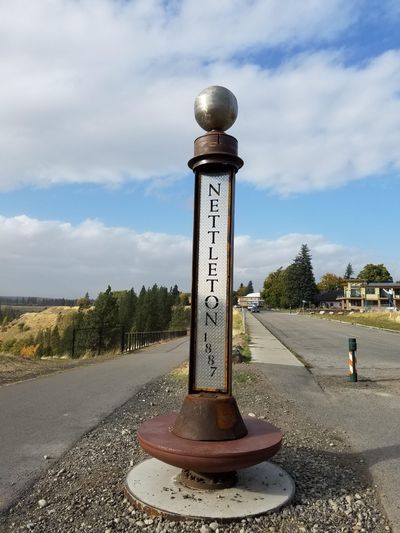Metal sculpture marks spot where old meets new: The historic district Nettleton’s Addition and emerging Kendall Yards neighborhood

Steffan Wachholtz bought into the idea of reusing materials in his artwork while still in college.
His latest creation is a tour de force, a metal sculpture marking the boundary between the historic Nettleton’s Addition and the emerging Kendall Yards development.
The new column joins three other similar pieces marking the boundaries of Nettleton’s Addition, which dates to 1887.
The artwork is located along the Centennial Trail at the west end of Kendall Yards near Broadway Avenue, overlooking the Spokane River.
A trail user stopped on Tuesday morning to congratulate the artist. “Well done. It is awesome,” the woman said.
The $6,000 sculpture was financed jointly by the West Central Neighborhood Council, the developer of Kendall Yards and Kendall Yards homeowners.
Nettleton’s Addition is the largest national historic district in Washington state.
The south side of the column marks the entrance to Nettleton’s Addition while the north side marks the entry to Kendall Yards.
The reclaimed metal column is on the Centennial Trail at the west end of West Bridge Avenue. The three previous sculptures, also created by Wachholtz, are located along Chestnut Street at Broadway, Boone and Maxwell avenues and were funded primarily by Spokane Preservation Advocates and Associated Garden Clubs of Spokane in 2008.
In the case of the new column, Wachholtz set the sculpture on a foundation that is 4 feet deep. He added seating to the lowest level. The column is made from scrap metal. Wachholtz said he found a steel I-beam for the main column and used aluminum sheeting to cut letters announcing the boundaries.
An old wheel hub, a concrete mold and ends of propane tanks were incorporated into the sculpture. A reused stainless steel ball adorns the top.
He said the artwork has been safe from vandalism and defacement.
“People seem to respect these things,” he said.
Wachholtz was raised in Spokane, but moved away and studied in California. He returned in 2002 and lives near the artwork. He has been an artist for 30 years.
According to a news release, Nettleton’s Addition was designated a Washington State Historic District in 2005 and a National Historic District in 2006.
“The purpose of the district was to raise awareness of the historic value of West Central, overall,” said Kevin Brownlee, who organized the historic district nomination and entrance sculpture projects. “Nettleton’s Addition was the largest of West Central’s historically justifiable boundaries, and it also had a compelling – and largely forgotten – backstory in the person of William Nettleton, who founded Duluth, Minnesota, and developed a large suburb in St. Paul before moving to Spokane.”
Brownlee’s news release goes on to say West Central’s housing stock includes early work by Spokane’s most notable architects, and was one of Spokane’s earliest streetcar suburbs, providing low-maintenance bungalows with proximity to the central business core. “Much of the property in Kendall Yards was originally platted as Nettleton’s Addition,” Jim Frank, CEO of Greenstone Homes, added. “Nettleton’s overall vision of smaller homes on smaller lots close to downtown has come full circle.”